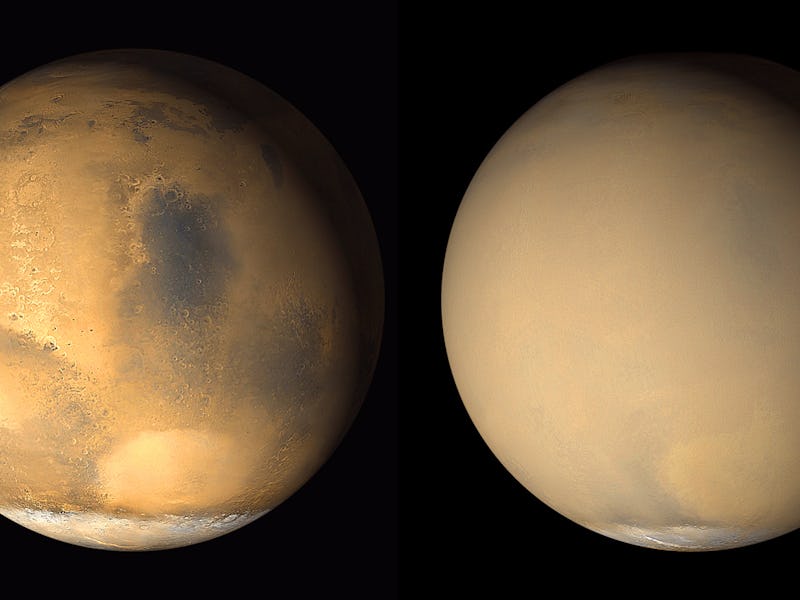As the Southeast braces for the monstrosity that is Hurricane Matthew, Mars is bracing for a different kind of storm: a global dust storm. And like meteorologists here on Earth, planetary scientists are trying to pin down when exactly these kinds of turbulent forces will flare up on the red planet.
If you’ve seen the sci-fi gem The Martian, you may recall the catastrophic dust storm that kicked off the movie. Martian dust storms, though common on the red planet, aren’t quite as intense in real life. Nevertheless, they can still wreak havoc on our communication systems and our robotic counterparts, roaming the red planet’s surface.
One such storm posed a major threat to the twin rovers, Spirit and Opportunity, back in 2007. According to John Callas, NASA’s project manager for the two rovers, the dust storm was so severe that the rovers were cut off from Earth, left to fend for themselves.
Before leaving the rovers to the elements, operators took special precautions to ensure the duo could survive with limited access to solar power during the worst parts of the storm. “Each rover powered up only a few minutes each day, enough to warm them up, then shut down to the next day without even communicating with Earth,” Callas said in a news release.
'The Martian'
Typically the storms are localized, but sometimes they join forces, blanketing entire regions of the planet in a thick haze. In even rarer instances, they can cover the whole planet in a shroud of dust.
Luckily, a group of researchers at NASA’s Jet Propulsion Laboratory in Pasadena, California, thinks it can predict when these global nuisances will strike.
As we know with Earth weather patterns, making predictions isn’t always easy. In fact, NASA scientists have been studying these storms for decades, and have spotted only nine global storms.
James Shirley, a planetary scientist at NASA’s Jet Propulsion Laboratory, thinks he can predict future storms by analyzing the planet’s orbital motion, which is affected by other planets. (Meaning, as Mars rotates around the sun, other planets tug on it).
“Global dust storms tend to occur when the momentum is increasing during the first part of the dust storm season,” Shirley explained in a news release. “None of the global dust storms in the historic record occurred in years when the momentum was decreasing during the first part of the dust storm season.”
Scientists predict the emergence of another global storm soon, as current conditions mimic those of previous storms. Mars will be monitored closely over the next few months to see if the predictions are correct.
“Mars will reach the midpoint of its current dust storm season on October 29th of this year,” said Shirley. “We believe it is very likely that a global dust storm will begin within a few weeks or months of this date.”
Predicting the emergence of dust storms could be a huge advantage for future astronauts hoping to live and work on the red planet. We certainly don’t want to deal with any real-life Mark Watney rescue situations when we finally begin to live and work on Mars.
